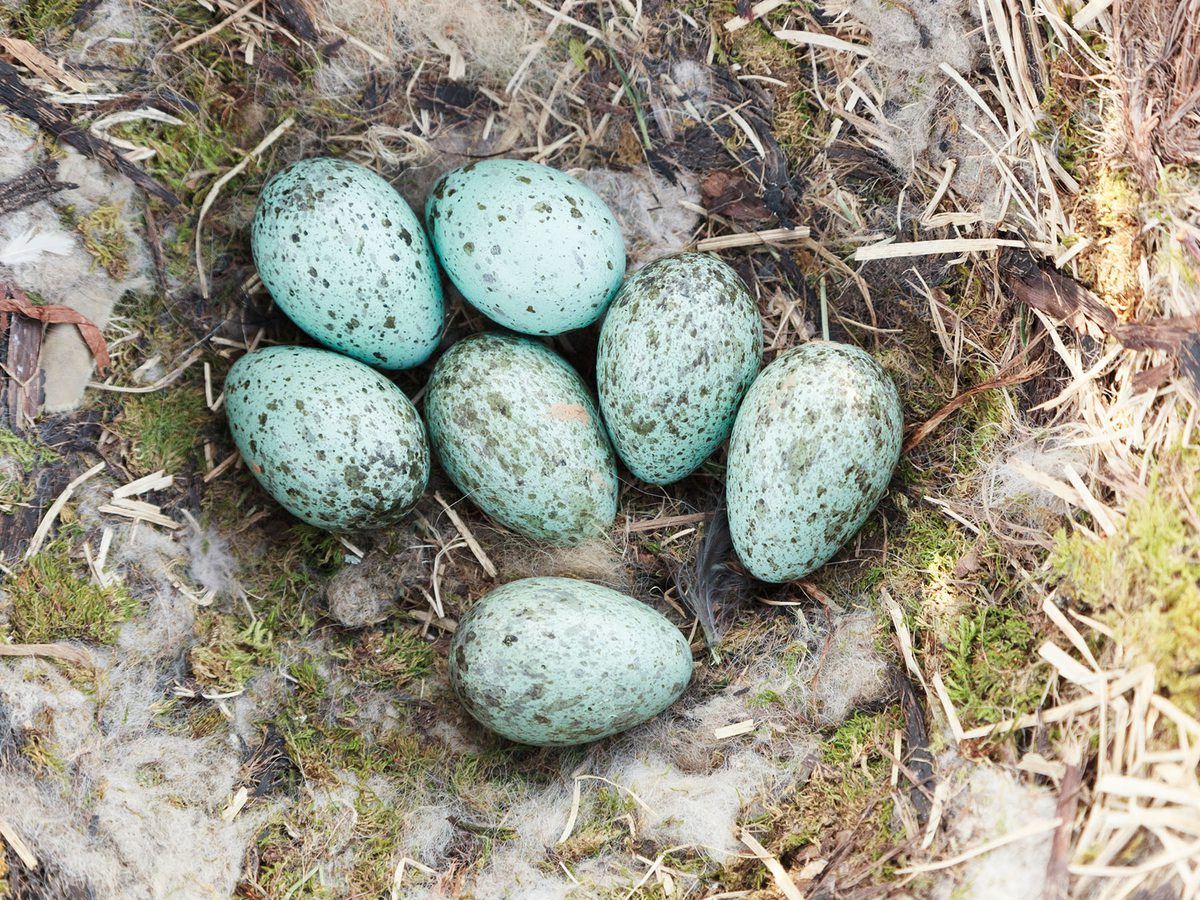The Common Raven (Corvus corax) is a large member of the Corvidae family, a group of highly-intelligent birds that includes crows, jays, magpies, and jackdaws. Common Ravens are not only impressive in stature but also have one of the widest distributions of any bird in the world, living almost throughout the Northern Hemisphere in a variety of habitats.
Have you ever wondered how and when Ravens nest?
Common Ravens build their nests on tall structures like cliffs and towers and often reuse the same nests or nest sites each year. They usually nest in the spring, and both parents work together over several months to raise a single brood of up to seven chicks.
Ravens build rather large, untidy nests, but their eggs are beautiful and often uniquely patterned. The young birds mature slowly and may spend several months in association with their parents after leaving the nest.
Would you like to learn more about the nesting habits of the Common Raven? Read along with us for more fascinating facts.

Common Raven adult feeding hungry chicks in the nest, built on the side of a cliff
Nest Location
Ravens are widespread breeding residents in North America, although they are absent from most of the eastern half of the United States. These crow-like birds are also widely distributed in the United Kingdom, from the Scottish Highlands to the Southwest of England.
Where do Ravens nest?
Ravens nest wherever there are abundant food resources and safe places to raise their young. Cliffs and trees are the most commonly used natural sites, although these adaptable and intelligent birds have learned to make use of many man-made structures.
Look out for Raven nests in the following places:
- Cliffs
- Tall trees in forests, woodlots, or open terrain
- Telephone poles and powerlines
- Abandoned buildings, bridges, and other large structures
Do Ravens nest in the same place every year?
Ravens often reuse the same nest year after year. They frequently rebuild in the same spot when the previous nest falls apart over the winter. New nests may be built near older ones, and many nests can accumulate in a suitable area over time. However, some pairs choose to nest several miles away from their previous nest site.
Do Ravens nest in backyards?
Ravens do occasionally nest in backyards with suitable nesting trees.

Close up of a Ravens' nest built high up in a tree
Do Ravens use nest boxes?
Ravens are not cavity nesters, although they prefer to build their nests under overhead shelters like a rock overhang or the foliage of the upper canopy. However, they will use nest boxes in areas where suitable nest sites are limited.
Researchers in Mongolia found that Ravens prefer to use artificial nest boxes with roofs.
What trees do Ravens nest in?
Ravens nest in various tree species, depending on what grows in their area. They prefer tall conifers that provide good shade and shelter, although they will even use large cacti like the Joshua Tree in the deserts of the American Southwest.
How high are Raven nests?
Ravens build their nests anything from 10 to 150 feet (3 - 46 m) above the ground. They usually build their nests about two-thirds of the way up, rather than on top of the cliff, tree, or other structure.

Young Raven chicks inside of the nest
Nest Appearance
Ravens may be large and widespread, but their nests aren’t always easy to find. Read on to learn how to identify the Raven’s nest.
What do Raven nests look like?
Raven nests are large, untidy baskets of sticks and twigs. The inner cup is deep and neat, providing a comfortable place for the growing chicks. Raven nests are much broader than deep and appear to be made entirely of twigs and sticks when seen from below.
How big are Raven nests?
Raven nests can become huge, although their maximum size is often dictated by the dimensions of the site. The largest nests can measure over five feet (1.5m) across and two feet (0.6m) deep.
Raven nest dimensions:
- Outside diameter: 16 to 60 inches (40 - 153cm)
- Outside depth: 8 to 24 inches (20 - 61 cm)
- Inside diameter: 9 to 12 inches (22 - 30 cm)
- Inside depth: 5 to 6 inches (13 - 15 cm)

A Ravens nest with seven unhatched eggs inside
Phenology
Ravens have an extended nesting season that varies significantly between pairs and across their range. Continue reading to learn more about the timing of Common Raven nesting.
What time of year do Ravens nest?
Common Raven nesting may begin as early as mid-winter or as late as early summer. Generally, they nest earliest in the far south of their range, where winter weather is relatively mild.
How long do Ravens nest for?
Raven nesting lasts several months, although the exact timing varies widely. Most nesting is complete within 9 to 15 weeks.
Read on for a breakdown of each phase in the Raven nesting cycle:
- Nest construction: It takes 9 to 21 days for a Raven pair to build their nests.
- Egg-laying: Female Ravens begin to lay their eggs a few days after the nest construction is complete and lay one egg per day. All told, this phase can last one to two weeks.
- Incubation: Raven eggs hatch after 20 to 25 days.
- Fledging: Raven chicks leave the nest after 4 to 7 weeks.
What month do Ravens lay eggs?
Most Ravens lay their eggs in March and April, although some birds lay as early as December and as late as June.
Where do Ravens nest in the winter?
Most of the Ravens' extended nesting season occurs in the spring, although nest building often starts in the winter. Common Ravens may start nesting in December or January in the south of their range.

A breeding pair of Ravens, perched on a tree
Nest Construction
Ravens often reuse old nests, simply refurbishing them as necessary. However, some pairs will build multiple nests in their territory over their lifetime.
How do Ravens build their nests?
Ravens build their nests by selecting a suitable site and collecting twigs to weave the basic bowl shape. The twigs are simply dropped and pushed into position on a platform structure such as a cliff.
However, the female may need to wedge and secure the material to create a sturdy starting point when nesting in trees.
Read on to learn which materials Ravens use to build their nests.
What do Ravens use for nesting?
Raven’s nests are built primarily from twigs and sticks up to about three feet (0.9 m) long and an inch (25 mm) in diameter. They line the inner cup with finer materials, including natural fibers like animal hair and wool. In urban areas, they also use artificial materials like paper.
Do male or female Ravens build the nest?
Female Ravens do most of the building, although males will assist. Males also bring in the majority of the building material.

Common Raven gathering nesting materials to build the nest
Raven Eggs
Few birdwatchers have the privilege of seeing Ravens’ eggs. They can be surprisingly bright and attractive for such a monochrome bird.
What do Raven eggs look like?
Ravens' eggs are very variable in color and patterning. They may be plain greenish or blueish, although most have brown or purple markings. The eggs measure up to about two inches (44 - 52 mm) long and one and a quarter inches (31 - 36 mm) across and weigh just over an ounce (30 g).
How many eggs do Ravens lay?
Ravens usually lay three to seven eggs, with an average clutch of about five.
Do male Ravens sit on eggs?
Female Ravens do most of the incubating, although males will also sit on the eggs, particularly to relieve the female in severe weather.

Ravens' Eggs
Fledgling and Parental Care
Baby Ravens hatch out as helpless and blind chicks. They require many weeks of care from their devoted parents to fledge the nest.
When do baby Ravens leave the nest?
Baby Ravens fledge the nest after four to seven weeks. They may stay in association with their parents for several weeks, even following them on long flights. However, fledglings from late nests become independent quite soon and may leave to join communal roosts with their siblings.
How many broods do Ravens have?
Ravens produce a single brood each breeding season. Nesting takes several months, which does not allow a second brood. However, pairs may lay a second or third clutch of eggs if the first brood fails.

Adult Raven feeding young fledgling chick
Raven Nesting FAQs
Do Ravens abandon their nests?
Ravens usually build their nests well above the ground, safe from predators and people. Some pairs build a new nest each year, sometimes far away, although many will reuse their nests over several years, making repairs where necessary.
Do Ravens nest on the ground?
Ravens do not usually nest on the ground. Most nests are at least 10 feet (3 m) up, although some build their nests at heights up to 150 feet (46 m).
Where do Ravens nest at night?
Ravens usually sleep in the safety of tall trees, although they also use cliffs and tall artificial structures like power lines. These birds often gather to roost in communal groups, each known as an 'Unkindness of Ravens'.

Common Raven fledgling perched on a branch
How to attract nesting Ravens
Attracting nesting Ravens is difficult because they prefer to nest on large structures like cliffs and tall trees. In open, treeless habitats like farmland, prairie, and desert, you might attract nesting Ravens by erecting tall platforms.
Is it illegal to remove a Raven's nest?
It is illegal to remove, or tamper with, an active Raven’s nest in the United States and the United Kingdom. However, you can remove their nests after the chicks have fledged and the nest is vacant.
How do you stop Ravens from nesting?
Ravens can be rather noisy birds and are considered pests in some areas. They are difficult to discourage because they usually nest in inaccessible places. However, limiting their access to food sources like trash can be an effective strategy.

